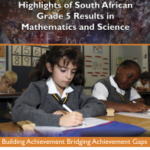TIMSS 2019 Highlights of South African Grade 5 Results in Mathematics and Science
Achievement and Achievement Gaps

TIMSS Assessment framework The curriculum used by TIMSS is broadly defined as the major organising concept in considering how educational opportunities are provided to learners and the factors associated with how learners use these opportunities. The TIMSS Curriculum Model has three aspects: the intended curriculum, the implemented curriculum, and the attained curriculum (see Mullis & Martin, 2017, for details. These represent the mathematics and science knowledge that learners are expected to learn as defined by countries’ curricula policies and publications, how the educational system should be organized to facilitate this learning, what is actually taught in classrooms, the characteristics of those teaching it, how it is taught, and, finally, what it is that learners have learned. TIMSS at the Grade 5 level in South Africa In 2015, South Africa extended the TIMSS programme and conducted the TIMSS 2015 Numeracy assessment at the fifth Grade, in order to gain an insight into education and achievement in primary schools. TIMSS Numeracy offered a ‘less difficult’ mathematics assessment at the fourth Grade than the mathematics assessment normally administered. TIMSS Numeracy asked learners to answer questions similar to those posed in TIMSS, except that easier numbers and more straightforward procedures were used. TIMSS Numeracy was reported on the same TIMSS Grade 4 scale. In TIMSS 2019, both mathematics and science assessments were included at the Grade 5 level. South Africa again opted for the less difficult mathematics assessment items, however, the science assessment was the same as all participating countries. The 2019 TIMSS cycle provides the first opportunity to set up a trend line for mathematics achievement and a baseline measure for science achievement. The TIMSS 2019 Grade 5 Sample The Department of Basic Education (DBE) and the Human Sciences Research Council (HSRC) collaborated in conducting the TIMSS 2019. The TIMSS 2019 sample of schools was selected from the 2018 DBE List of Schools that offered Grade 5 classes (school population: 16 254 public and 1 031 independent). Statistics Canada selected the national sample based on province and school type (public or independent) as explicit stratification variables and school poverty ranking as the implicit stratification variable. The realised sample consisted of 297 schools, 294 mathematics educators, 295 science educators, 11 903 learners and 11 720 parents. We explain the methodology in detail in the forthcoming TIMSS 2019 Grade 5 National Report.
